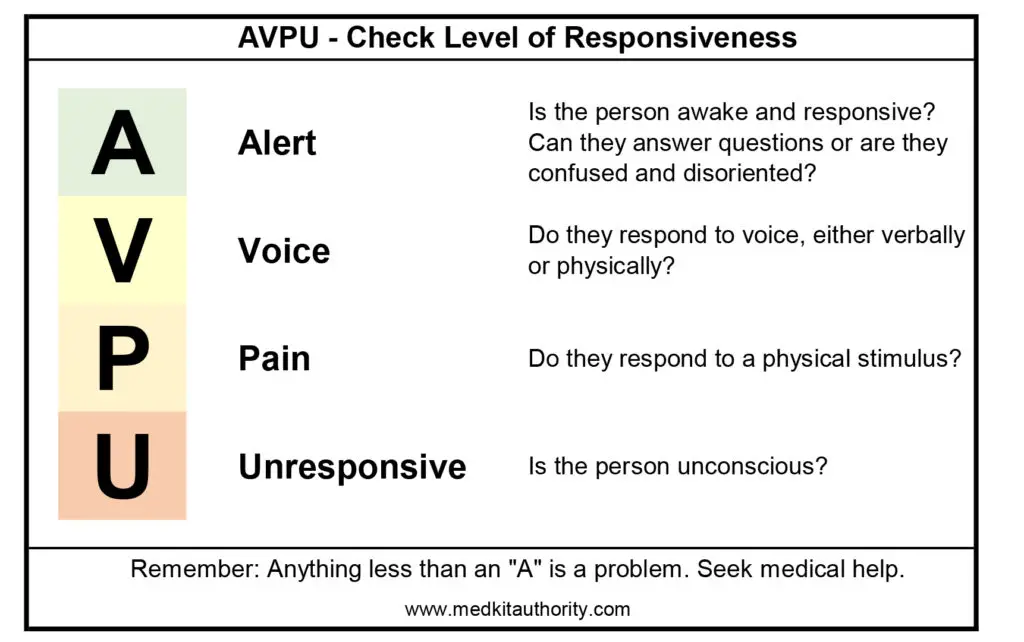You’ve come across somebody you think might be injured. As you assess the situation (maybe using the DRSABCD method) you’ll naturally try to figure out if they are conscious or ask them questions to see if they are ok. This is where AVPU or ACVPU can be useful.
AVPU is an acronym to help a first aid provider to determine general brain function and is common among first responders. It is a four-level scale that measures the LOR, or Level of Responsiveness. It’s a simplified version of the Glasgow Coma Scale, which was a 15 point scoring system created in the 1970s. AVPU is easy enough for anyone to remember and can be a useful way to organize your thoughts when explaining the situation to first responders.
AVPU Scale
The 4 levels of response are:
Alert
The person is clearly awake.
- You’ll want to note the person’s mental state – are they disoriented, aggressive, confused, etc.?
- Do they know their name? The date? Where they are?
- Are they having trouble speaking?
Voice
Responds to voice, either by opening their eyes or moving
- Can they respond to questions?
- Do they respond to commands or requests?
- Voice doesn’t mean that they have to respond with their own voice, only that they will respond to yours.
- Knowing the C.O.W.S. acronym is useful for this step.
Pain
Does the casualty respond to physical stimulus?
- Try squeezing their shoulders firmly
- Try pinching the tip of their finger
- Reactions may come in the form of moaning or movement, like pulling away or flinching
Unresponsive
Is the person unconscious?
- Does the person respond to any stimuli?
- If the person is not awake, then they are considered unconscious.
- Seek professional help if you haven’t already.
- Move them to the recovery position if there is no sign of spine injuries or check the ABC’s of first aid if you’re trained until help arrives.
AVPU Score Interpretation
Anything less than an “A” is a bad sign and an indication that help is needed. You’ll want to monitor the victim at regular intervals while you wait for help and note any changes, especially if the patient gets worse.
ACVPU: An update to the scale
As the AVPU acronym was used, it was determined that an additional level of the evaluation was necessary. Confusion was added as a way to differentiate between a person who is alert and aware of their surroundings versus someone who is awake but confused, disoriented, or in an altered state. These signs could indicate a brain injury.
ACVPU stands for:
- Alert
- Confusion
- Voice
- Pain
- Unresponsive
Signs of head injuries include:
- Headache
- Confusion
- Problems with balance
- Irritability
- Dizziness or feeling sick
- Loss of memory
- Bumps, bruises, or bleeding from the head
ACVPU was integrated into the National Early Warning Score which seeks to standardize medical assessments in the UK. It is one of several factors in the NEWS scoring system.
AVPU & ACVPU Score Charts


AVPU and ACVPU are both quick and easy ways for first aiders to assess a patient and are used by first responders every day.
Sources:
https://www.ncbi.nlm.nih.gov/books/NBK538431/
https://ed-carbonell.wixsite.com/nursetalks1/post/assessment-for-levels-of-consciousness-acvpu-and-the-glasgow-coma-scale
Cover Image: https://www.flickr.com/photos/britishredcross/3524682619/in/photostream/, cropped
Are you a first responder who uses AVPU? Tell us your experience in the comments.




